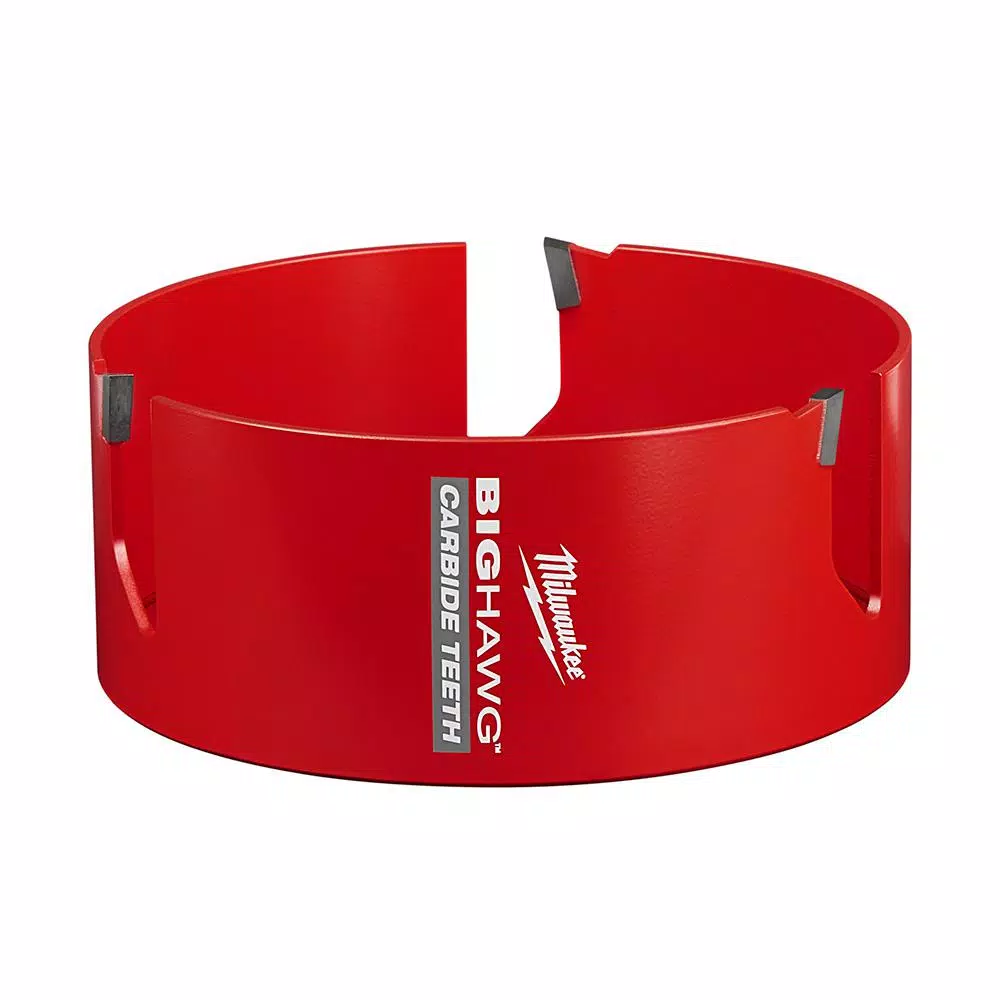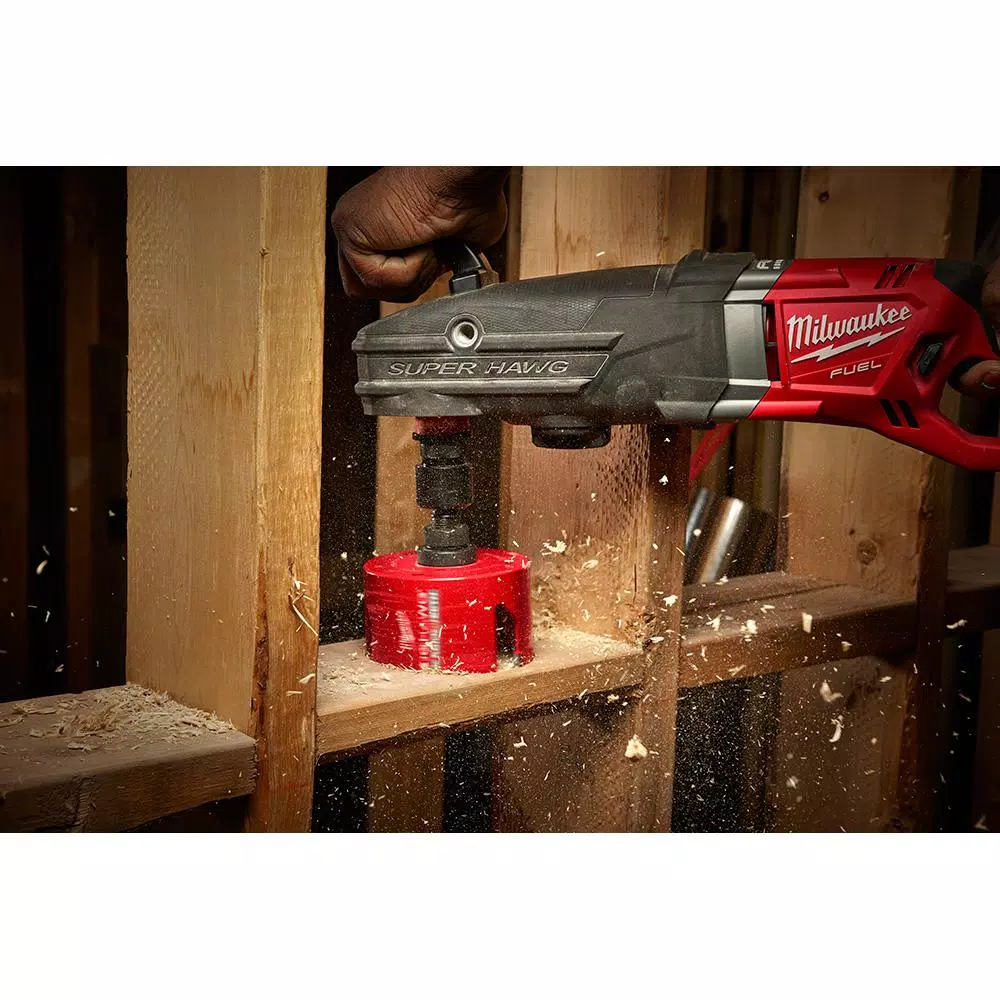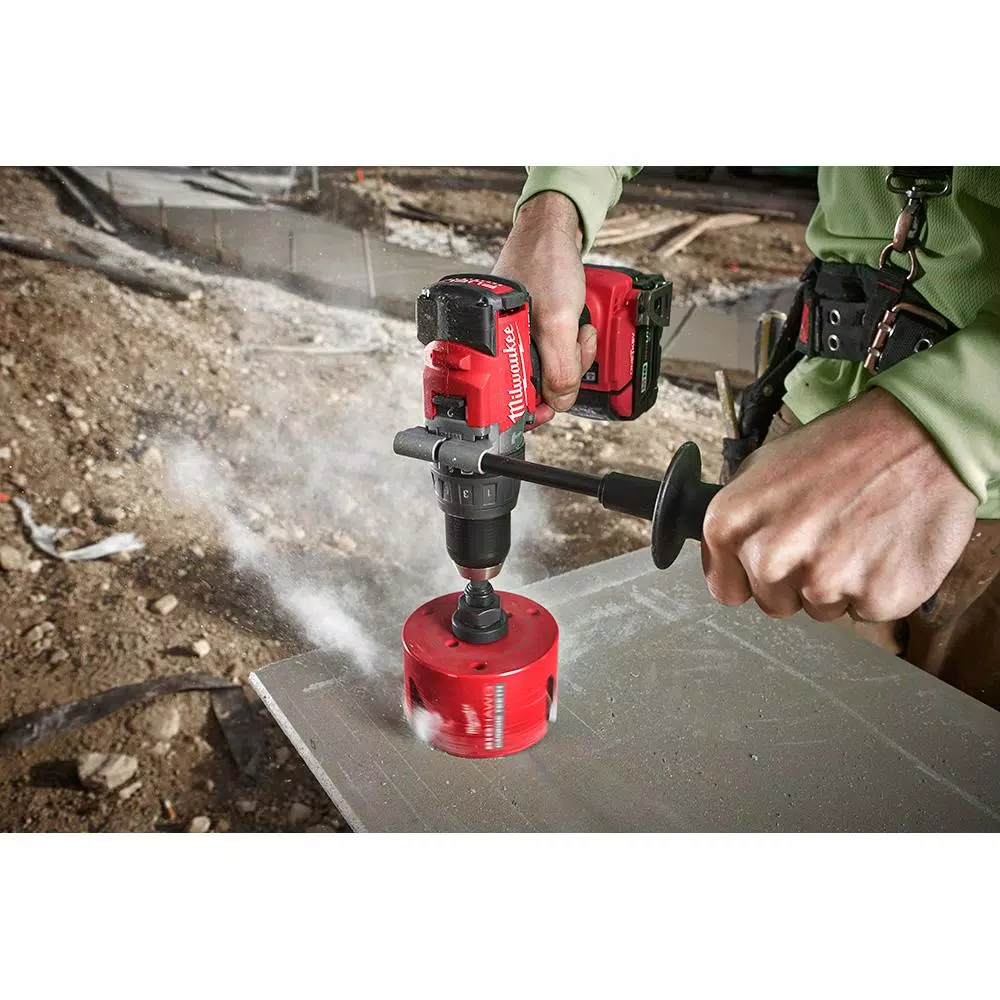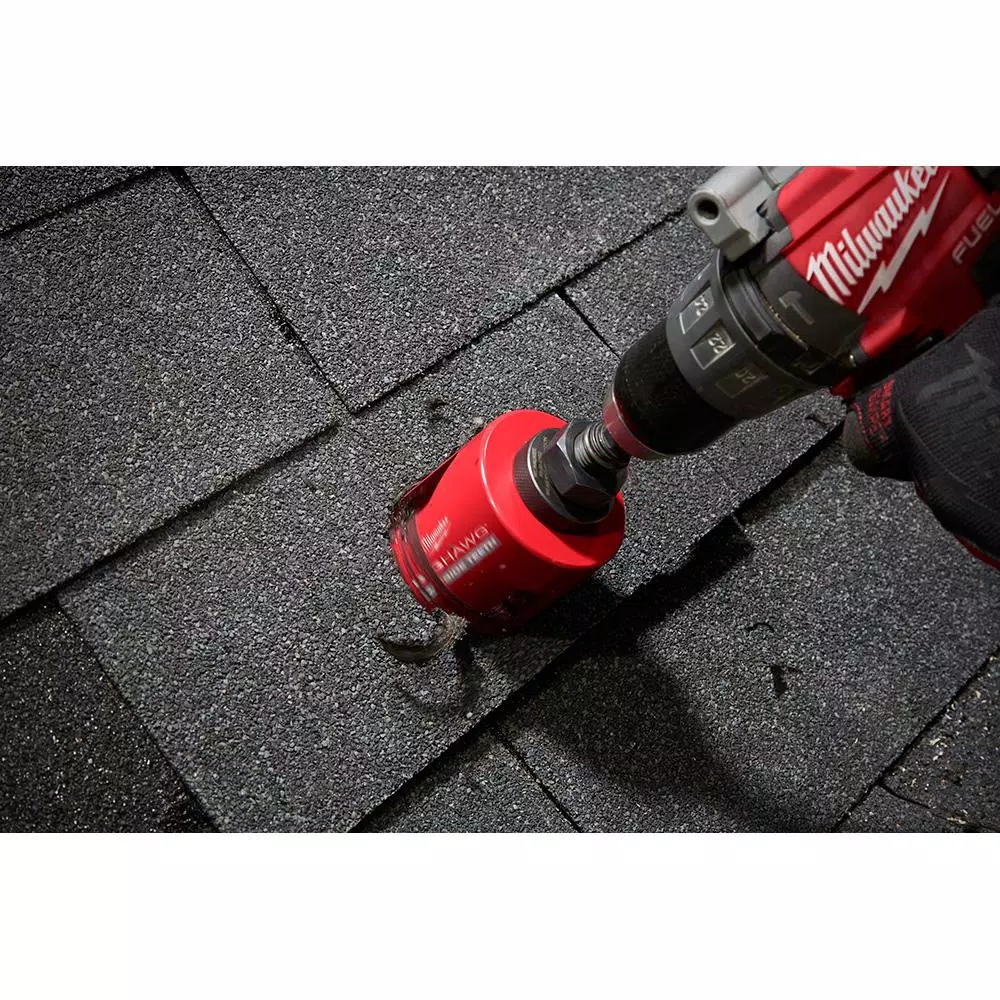Milwaukee 6-1/4 in. Big Hawg Carbide Hole Saw
$86.97
The BIG HAWG with Carbide Teeth hole saw delivers 50X life and 10X larger carbide teeth for heavy duty wood and abrasive material applications.
In stock
Description
The MILWAUKEE BIG HAWG with Carbide Teeth is the best hole saw solution for nail-embedded wood and abrasive material applications. This first-to-market hole saw offers extreme life utilizing advanced carbide technology. The BIG HAWG gives users 50X more life in demanding applications with the ability to cut 1000+ more nails. The heavy duty hole saw has 10X larger carbide teeth that rip through materials five times faster. Deeper slots allow for fast and easy plug removal. The BIG HAWG hole saw is the best solution for cutting through the toughest materials, including nails, cement board, shingles, plaster and stucco.
- 10X larger carbide teeth
- 3 tooth design for fast aggressive cuts
- Carbide tipped multi-material pilot bit for increased material versatility
- Thicker backer for extreme life in demanding applications
- Optimized slot design for fast plug removal
- Enlarged braze surface for stronger bond to the carbide teeth
- Cuts wood, nails, shingles, cement board, plaster and more
- Includes: (1) 6-1/4 in. BIG HAWG with carbide teeth
Additional information
| Weight | 2.82 lbs |
|---|---|
| Dimensions | 2.93 × 7.52 × 8.78 in |
| Arbor included | No |
| Bit Diameter | 3/8 in |
| Bit Length (in.) | 3.5 |
| Bit Material | Carbide |
| Drill Bit Type | Hole Saw |
| Drill Bit Type(s) Included | Hole Saw |
| Drilling Depth (in) | 2.43 |
| Hole Saw Diameter (in) | 6-1/4" |
| Individual/Set | Individual |
| Material Cut | Multi-Purpose |
| Min Chuck Size Required | 1/2 In. |
| Model | 49-56-9275 |
| Pilot Bit Included | No |
Reviews (70)
70 reviews for Milwaukee 6-1/4 in. Big Hawg Carbide Hole Saw
Only logged in customers who have purchased this product may leave a review.
Related products
Drill Bits
Model# FB-005Drill Bits
Model# DW2542Drill Bits
Model# 282303Drill Bits
Milwaukee 18 in. x 7/16 in. Bit Extension Bit Extention For Selfeed Bits and Hole Saws
Model# 48-28-4011Drill Bits
Bosch Carbide-Tipped Rotary SDS-Plus Hammer Bit Set (7-Piece)
Model# HCK001Drill Bits
Milwaukee 18 in. x 7/16 in. QUIK-LOK Universal Extension Bit
Model# 48-28-1050Drill Bits
Model# DW2045 GDrill Bits
Model# 48-28-1010






























Dejuan Mayert (verified owner) –
While traditional bi-metal hole saws still have their place in certain applications, for rough holes in framing members 3-tooth carbide hole saws, such as these Milwaukee Big Hawgs, can’t be beat.As a residential electrical contractor, boring holes in wood framing members is something I do most days – some days, much of the day. For many years, self-feed bits were the only real option to the professional for larger holes. While they also provide for rapid boring, one good nail strike and they require costly sharpening. They also require a lot of drill. The Big Hawgs, were they are only cutting the kerf of the saw out, require a lot less drill, making them ideal, with today’s cordless job. This 4″ model is an 8-second hole through 2x pine framing with my M18 Hole Hawg. With the smaller drill pictured it was roughly a 15-second hole, as I dropped it down to low gear (which I would not recommend anyone other than a pro user doing – I only used this size drill to show how efficiently these Big Hawgs cut).Again, these are designed for rapid large holes through framing and other construction materials, and excel at it. If you require a more refined hole, or are drilling through thin, brittle material – such as vinyl siding – a traditional hole saw is what you seek.
Antwon Gorczany (verified owner) –
While traditional bi-metal hole saws still have their place in certain applications, for rough holes in framing members 3-tooth carbide hole saws, such as these Milwaukee Big Hawgs, can’t be beat.As a residential electrical contractor, boring holes in wood framing members is something I do most days – some days, much of the day. For many years, self-feed bits were the only real option to the professional for larger holes. While they also provide for rapid boring, one good nail strike and they require costly sharpening. They also require a lot of drill. The Big Hawgs, were they are only cutting the kerf of the saw out, require a lot less drill, making them ideal, with today’s cordless job. This 5-1/4″ model is roughly an 8-second hole through 2x pine framing, in my M18 Hole Hawg.Again, these are designed for rapid large holes through framing and other construction materials, and excel at it. If you require a more refined hole, or are drilling through thin, brittle material – such as vinyl siding – a traditional hole saw is what you seek.
Evie White (verified owner) –
this hole saw does a great job. Cuts through plaster like butter
Brandi Huels (verified owner) –
I waited a while to write a review on this hole saw from Milwaukee because I wanted to see the results of it in real world testing. I install electrical conduit and use hole saws everyday. I used the 3″ carbide toothed saw to cut through metal, plywood, 2×8’s and such. The real test was to make multiple cuts one after the other through a commercial roof, rubber membrane, tar, steel , wood and foam insulation. The big hawg hole saw never slowed Down even with a 12″ extension attached to it. I don’t have a picture of it because it would not do it justice. I will be getting more of them I the future.
Raul Weissnat (verified owner) –
Better than expected , did the job other bits wouldn’t
Colt Shanahan (verified owner) –
These hole saws work great. I have already ordered more.
Melody Zieme (verified owner) –
If you need to put vent holes through Hardi or similar siding, this is your tool. The bimetalic drills will wear out after two or three holes. This thing cuts fast and just keeps cutting.
Hope Hackett (verified owner) –
2-1/8 in. Milwaukee Big Hawg Carbide Hole Saw is for fast hole cutting in wood even with nails embedded in the wood. Each Hawg bit is rated for cutting 1000 nails. This is a very aggressive fast cutting hole saw that leaves reasonable smooth holes in the wood. This is a rough-cut hole saw and will not replace a fine-tooth hole saw, when very smooth holes are needed as in finish or cabinet work. This is the actual cutting head and you will need the typical one-inch arbor that holds replaceable pilot bits. At a slow speed this cuts fast and cuts with-out any resistance when cutting nails. At 1500 RPMs your wrist will tell you when you hit a nail. The Hawg cuts through nails without any visible damage to the three thick carbide teeth. This is an excellent fast cutting large bore hole cutter. Photos show evidence of an embedded nail in the stud prior to installing a whole house vac pipe. Wood plugs drop out easily compared to other hole saws and easily drills holes up to; 2 7/16 deep. Another fine product from Milwaukee.
Kari Keeling (verified owner) –
Great!
Mason Ebert (verified owner) –
This is another of those products that takes a SawzAll and a half stick of dynamite to get it out of the packaging, which is really, really annoying (I dinged it one star for that). Other than that, the carbide tips are thick and sharp and can probably be sharpened several times if one had the capability of doing that. It takes a standard arbor, which anyone who regularly uses hole saws should have (as opposed to a Freud/Diablo hole saw I recently purchased, which only accepts a Freud arbor), and it is fairly deep–a full two inches even after accounting for the arbor protrusion. If you are new to large hole saws and have a powerful 1/2″ drill (all of the arbors for this size hole saw require a 1/2″ drill, unless you can find an adapter somewhere), start your cut slowly to minimize binding or you are likely to end up with a sprained wrist. Once the teeth are buried in the hole, binding is less likely as long as you keep the saw straight.